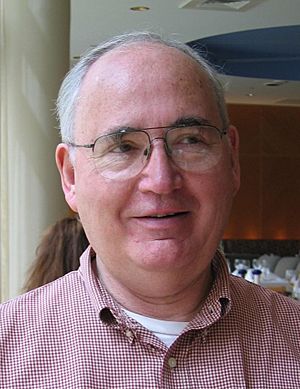Dana Scott facts for kids
Quick facts for kids
Dana Stewart Scott
|
|
|---|---|
 |
|
| Born | October 11, 1932 |
| Education | University of California, Berkeley (BA) Princeton University (MA, PhD) |
| Known for |
|
| Awards |
|
| Scientific career | |
| Fields | |
| Institutions | |
| Thesis | Convergent Sequences of Complete Theories (1958) |
| Doctoral advisor | Alonzo Church |
| Doctoral students |
|
Dana Stewart Scott (born October 11, 1932) is an American scientist who has done amazing work in computer science, mathematics, and philosophy. He is a retired professor from Carnegie Mellon University and now lives in Berkeley, California.
Scott is famous for his work on how computers think and solve problems, which is called automata theory. This important work earned him the Turing Award in 1976, which is like the Nobel Prize for computer science. He also worked with Christopher Strachey to create the basic ideas for understanding how computer programming languages work. Scott has also explored modal logic, topology, and category theory, which are all advanced areas of math and logic.
Contents
Early Life and Studies
Dana Scott earned his first degree in Mathematics from the University of California, Berkeley, in 1954. He then went to Princeton University for his advanced degrees. There, he completed his Ph.D. (Doctor of Philosophy) in 1958. His main teacher for his Ph.D. was Alonzo Church, a very famous logician.
Scott started his studies in logic at Berkeley in the early 1950s. He quickly showed how smart he was and joined advanced classes. He worked closely with another famous logician, Alfred Tarski. Even though they had a disagreement for a short time, they later became friends again. Tarski even told Scott, "I hope I can call you my student."
After finishing his Ph.D., Scott taught at the University of Chicago until 1960.
Working with Computers and Logic
In 1959, Scott published an important paper with his friend Michael O. Rabin. This paper introduced a new idea called "nondeterministic machines" to automata theory. Imagine a machine that can make choices at different steps, leading to many possible paths. This idea was very new and important for understanding how computers solve problems.
Because of this groundbreaking work, Scott and Rabin both received the Turing Award. This award recognized their contribution to understanding how complex computer problems can be solved.
Back to Berkeley: New Ideas
From 1960 to 1963, Scott was an Assistant Professor of Mathematics at the University of California, Berkeley. During this time, he focused on classic topics in mathematical logic, like set theory and model theory.
He made a big discovery in set theory. He showed that a concept called the axiom of constructibility cannot exist at the same time as something called a measurable cardinal. This was a very important finding in the field of set theory.
Scott also started guiding his own Ph.D. students during this period.
Exploring Modal and Tense Logic
Scott also began working on modal logic, which deals with concepts like "it is necessary that" or "it is possible that." He worked with John Lemmon and was very interested in how Arthur Prior looked at tense logic, which is about how time is used in language.
Scott also worked with Richard Montague, whom he knew from his time as a student at Berkeley. Together, Scott and Montague found a new way to understand modal and tense logic, which is now called Scott-Montague semantics.
Scott and Lemmon started writing a textbook on modal logic. Even though Lemmon passed away before it was finished, Scott shared the unfinished book. It introduced important ways to understand modal logic, which are still used today. Scott later published the work as An Introduction to Modal Logic in 1977.
New Discoveries in Logic
Between 1963 and 1972, Scott worked at Stanford, Amsterdam, and Princeton. During this time, he developed the idea of a Boolean-valued model.
In 1967, Scott published a paper that offered a different way to prove that the continuum hypothesis cannot be proven true or false using standard set theory rules. This work was so important that he received the Leroy P. Steele Prize in 1972.
Oxford and Programming Languages
In 1972, Scott became a Professor of Mathematical Logic at the University of Oxford in England. He was part of Merton College and is now an honorary member there.
Understanding Computer Programs
At Oxford, Scott worked with Christopher Strachey. Together, they created a mathematical way to understand how programming languages work. This is known as the Scott–Strachey approach to denotational semantics. It was a huge step forward in theoretical computer science.
One of Scott's key ideas was domain theory. This theory helps explain how computer programs, especially those with repeating actions or functions, can be understood mathematically. He also helped us understand how computers handle endless amounts of information.
Scott's work during this time led to many awards, including:
- The 1990 Harold Pender Award for using logic and math to understand programming languages.
- The 1997 Rolf Schock Prize for creating domain theory, which helped apply logical ideas to programming languages.
- The 2001 Bolzano Prize for his achievements in mathematical sciences.
- The 2007 EATCS Award for his contributions to theoretical computer science.
Carnegie Mellon University
From 1981 to 2003, Scott worked at Carnegie Mellon University. There, he suggested a new theory called equilogical spaces. This theory was an improvement over domain theory and had many benefits.
In 1994, he became a Fellow of the Association for Computing Machinery, a group for computer professionals. In 2012, he also became a fellow of the American Mathematical Society.
See also
 In Spanish: Dana Scott para niños
In Spanish: Dana Scott para niños

